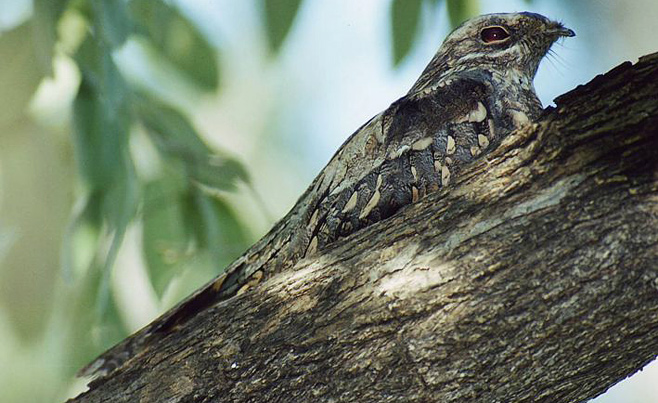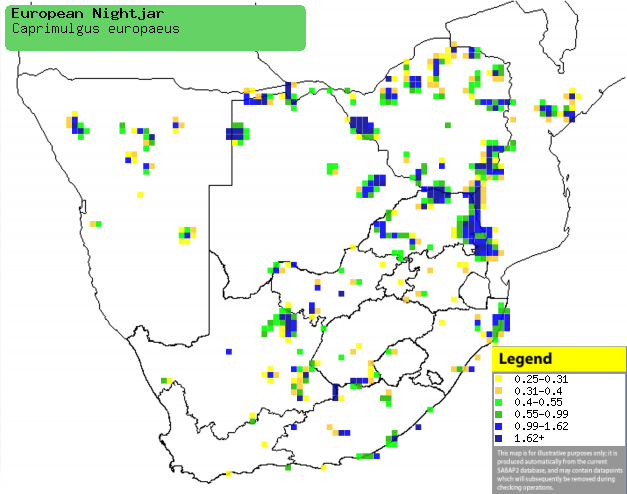|
Caprimulgus europaeus (European
nightjar)
Europese naguil [Afrikaans]; Udebeza [Xhosa]; uZavolo
(also applied to Fiery-necked nightjar) [Zulu]; Rumbamba (generic term for
nightjar) [Kwangali]; Semanama (generic term for nightjars) [South Sotho];
Datiwa (generic name for nightjar) [Shona]; Mahulwana, Ribyatsane, Riwuvawuva
(generic terms for nighjar) [Tsonga]; Leubauba, Mmapheke, Tshogwi (all 3 are
generic terms for nightjar) [Tswana]; Nachtzwaluw [Dutch]; Engoulevent d'Europe
[French]; Ziegenmelker, Nachtschwalbe [German]; Noitibó da Europa [Portuguese]
Life
> Eukaryotes >
Opisthokonta
> Metazoa (animals) >
Bilateria >
Deuterostomia > Chordata >
Craniata > Vertebrata (vertebrates) > Gnathostomata (jawed
vertebrates) > Teleostomi (teleost fish) > Osteichthyes (bony fish) > Class:
Sarcopterygii (lobe-finned
fish) > Stegocephalia (terrestrial
vertebrates) > Tetrapoda
(four-legged vertebrates) > Reptiliomorpha > Amniota >
Reptilia (reptiles) >
Romeriida > Diapsida > Archosauromorpha > Archosauria >
Dinosauria
(dinosaurs) > Saurischia > Theropoda (bipedal predatory dinosaurs) >
Coelurosauria > Maniraptora > Aves
(birds) > Order: Strigiformes > Family: Caprimulgidae
 |
|
European nightjar, Kruger National Park, South
Africa. [photo Trevor Hardaker ©] |
The European nightjar is a Palearctic breeding migrant, with
its non-breeding grounds mainly in West and East Africa, but also to a lesser
extent in southern Africa. It arrives in our region around September-October,
after a long and difficult flight from Eurasia. It occurs in spaced out
populations across southern Africa, generally preferring woodland and savanna.
It exclusively eats flying insects, especially beetles, doing most of its
foraging at dusk and a few hours before sunrise. It stays here for about a half
a year, most of the birds have left by the end of April.
Distribution and habitat
Breeds in Eurasia, heading south in the non-breeding season
to West Africa, as well as the area from Ethiopia south to Zambia and southern
Africa. Within southern Africa it is generally uncommon, occurring in patches
across the region. It generally prefers savanna and woodland, especially miombo (Brachystegia),
mopane (Colosphermum mopane) and Acacia woodland, but it can also
be found in gardens and parks. Unlike most other nightjars, it roosts lengthways
on tree branches in the day (see image above).
|
 |
|
Distribution of European nightjar in southern Africa,
based on statistical smoothing of the records from first SA Bird Atlas
Project (©
Animal Demography unit, University of
Cape Town; smoothing by Birgit Erni and Francesca Little). Colours range
from dark blue (most common) through to yellow (least common).
See here for the latest distribution
from the SABAP2. |
Movements and migrations
Palearctic breeding migrant,
arriving in southern Africa around September-October, after a long and difficult
flight from Eurasia. It stays in the region until about April.
Food
It almost exclusively eats flying insects, especially
beetles, doing most of its foraging at dusk and a few hours before sunrise. It
usually hunts from a perch overlooking an open area, such as a cultivated field,
occasionally launching into the air to catch an insect before returning to its
perch. It is extremely fast and agile in flight, sometimes hawking insects
attracted to electric lights in urban areas. The following food items have been
recorded in its diet:
Threats
Globally not threatened, however its population in Europe
has been decreasing recently, probably due to habitat loss, human disturbance
and lack of insects to eat because of pesticides. Also, thousands of them are shot
down as migrating flocks fly over the Mediterranean Sea.
|
